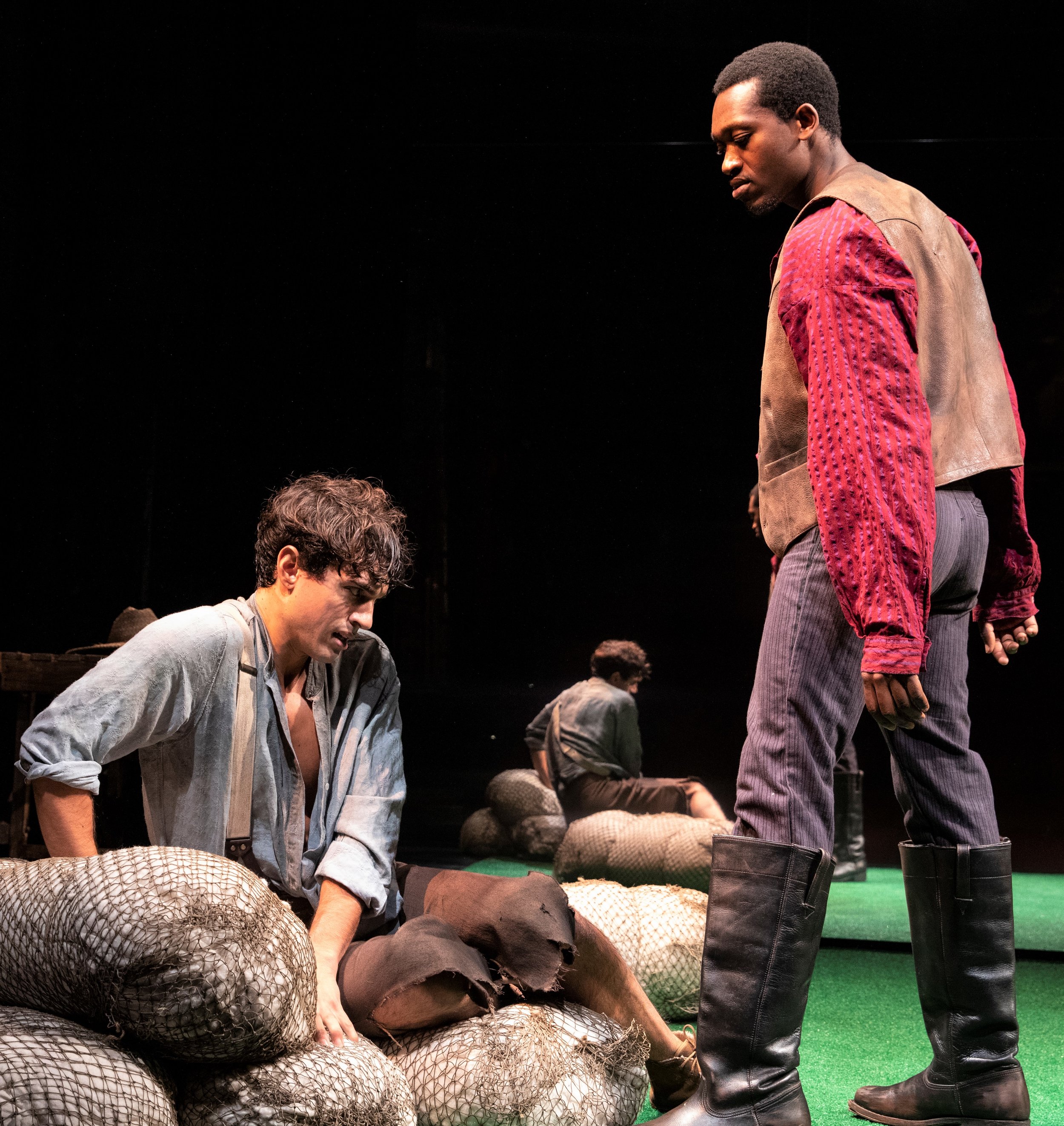Jeremy O. Harris makes an impressive splash with Slave Play, a fascinating, often hilarious, sometimes bumpy, and ultimately serious look at sex and power in modern interracial relationships. The New York Theatre Workshop production also whets one’s appetite for Daddy, a second play of Harris’s that will be seen in the spring at the Vineyard Theatre.
Although Slave Play has three distinct acts—Work, Process, and Exorcise—director Robert O’Hara has compressed them into an intermissionless whole. The work opens with a comely black woman, Kaneisha (Teyonah Parris) sweeping up; she wears the worn clothing of a servant in the Old South (by costumer Dede Ayite). When her white overseer Jim (Paul Alexander Nolan) arrives, she bends over and waggles her ample behind as he watches her lustfully. It’s clear that Kaneisha is playing up to him—to avoid a beating, perhaps?—and using her sexual wiles to stoke his libido.
Sullivan Jones (left) plays Phillip and Annie McNamara is Alana in Jeremy O. Harris’s Slave Play at the New York Theater Workshop. Top: Teyonah Parris (left) as Kaneisha and Paul Alexander Nolan as Jim.
As soon as they arrive at what both have been desiring, the scene shifts to a bedroom of the same period; here a middle-aged Scarlett O’Hara type (Annie McNamara) named Alana summons her liveried black servant, Phillip—a tall, well-spoken Sullivan Jones—to attend to her, specifically to play his violin. Soon, however, his mistress is pawing him and, after pulling out a large dildo, she orders him drop his pants.
Once again the scene shifts, to a barn and a third couple. James Cusati-Moyer is a white indentured servant named Dustin, and Ato Blankson-Wood is a slave, Gary, who has been appointed Dustin’s overseer. Again, there are sexual undercurrents, this time homosexual. Issues of who desires whom, who wields power, and who receives the sexual gratification are at play in all three, but suddenly, as the couples are going at it in different pools of light (designed by Jiyoun Chang), Jim stops the show by yelling “Starbucks” repeatedly. Two women in modern dress then burst in on the action, and a blackout ensues.
When Chang’s lights come up, the setting is a rehearsal room with yellow metal folding chairs, and the characters enter for a talkback. All the couples have been trying to work out their sexual problems in a program devised by an interracial lesbian couple, Teá (Chalia La Tour) and Patricia (Irene Sofia Lucio). The double meaning of the title becomes apparent, as does the reason for set designer Clint Ramos’s wall of mirrors upstage: self-reflection and identity are key elements of the story. As Harris skewers racial stereotypes, psychobabble, white guilt (or worse) and touchy-feely jargon, the satire takes off.
“There’s a real materiality to our psychic spaces,” says Teá. “And day four is all about manipulating those psychic spaces like the raw material they are in order to process the anhedonia, right? The emotional numbing that’s brought us all here together, in this room.”
During the session, Cusati-Moyer has the richest comedy as his wildly overwrought Dustin, an actor, insists “I’m not white” in spite of all observable evidence. Harris has ratcheted up white guilt to white self-loathing, and Cusati-Moyer makes the most of the conceit: “I’m not white! I said that Day 1! I’m not white! I’m not. Please, don’t fucking say that. It’s ignorant. It’s erasure and it’s—that’s...that’s fucking violent.”
James Cusati-Moyer plays Dustin and Ato Blankson-Wood is Gary. Photographs by Joan Marcus.
But the satire isn’t limited to the racial aspects. Alana sees the benefits of the therapy with a feminist slant: “I don’t know that there has ever been a time when I’ve known how to tell a man what I’ve wanted or have felt free to follow every embarrassing impulse I’ve had …” Jones’s self-assured Phillip, played with an easygoing cool, rolls with the punches (as well as his reported erectile dysfunction), as it were.
Although the second act provides the most laughter and opportunities for everyone to shine, the satire goes on a bit too long.
In the final segment the tone turns dark again, as Jim tries to win back Kaneisha, who’s so angry that he stopped the therapy that she has broken up with him, telling him, “You’re a virus.” Jim assumes his antebellum character again, and suddenly they’re engaged in a rough sexual encounter that ends ambiguously. Whether the dramatist’s overall message is that interracial romances have unique, perhaps insurmountable problems, or whether racial identities come with too much baggage to overcome sexual attraction, is unclear. Even if Harris’s control of his considerable talent wobbles occasionally, the results are riveting and thought-provoking.
Jeremy O. Harris’s Slave Play runs through Jan. 13 at New York Theatre Workshop (79 E. 4th St.). Evening performances are at 7 p.m. Tuesday through Thursday and on Sunday, and at 8 p.m. Friday and Saturday; matinees are at 2 p.m. Saturday and Sunday. For information and tickets, call the box office at (212) 460-5475 or visit nytw.org.





